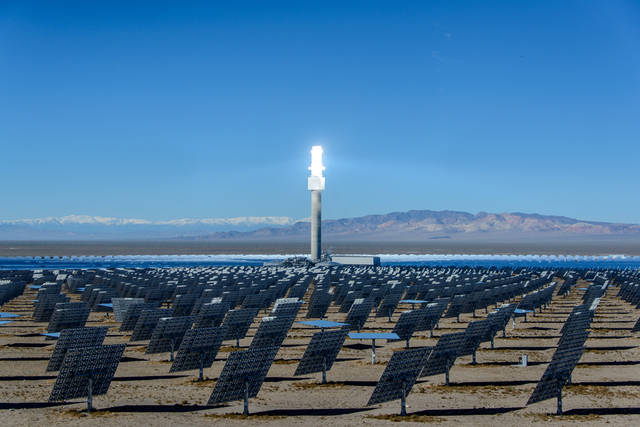
Crescent Dunes Solar Energy Project near Tonopah reported $106,451 in profits during the second quarter of 2019, according to the report filed with Federal Energy Regulatory Commission. But according to the last three quarterly reports filed by the parent of the plant, Tonopah Solar Energy LLC with the Federal Energy Regulatory Commission, the plant’s earnings show a downward trend.
Crescent Dunes’ earnings have been down since the third quarter of 2018 when it reported $12.2 million. Since then, it has generated $5.1 million in the fourth quarter of 2018 and $6.5 million from Jan. 1 through March 31 (the first quarter) of 2019.
The second quarter of 2019 report also shows only one line operating, while the first quarter showed three lines operating at the facility. During the first and second quarters of 2019, the average price in megawatts per hour at Crescent Dunes was $139.16, according to the report.
The second-quarter report highlights earnings from April 1 through June 30 of 2019.
Tonopah Solar Energy LLC is a subsidiary of SolarReserve, a Santa Monica, Calif.-based privately held company that calls itself a leading global developer of utility-scale solar power projects, including electricity generation by solar thermal energy and photovoltaic panels.
SolarReserve officials didn’t respond to requests for comment.
NV Energy contract
The electricity from Crescent Dunes is sold to NV Energy under a 25-year fixed-price contract. The NV Energy 2018 Portfolio Standard Annual Report, which outlined the company’s compliance with Nevada’s Renewable Standard (RPS), called Crescent Dunes “the biggest resource uncertainty” facing Nevada Power (doing business as NV Energy).
“The ability of this generating resource to meet its contractual portfolio credit commitments is key to Nevada Power’s ability to maintain compliance in the near term. Although the plant improved its performance in 2018, it once again missed its contractual credit supply requirement by a significant margin. If Crescent Dunes continues to perform at historical levels, Nevada Power’s current credit reserve may be insufficient to overcome chronic, multi-year credit shortfalls,” the report said.
A message was left with NV Energy.
Background
Crescent Dunes is a 110-megawatt solar thermal project that was issued the U.S. Department of Energy $737 million loan guarantee in 2011. The plant uses power tower technology that concentrates solar energy to heat molten salt, converting that heat into electricity.
Crescent Dunes experienced its first major issue when its earnings were previously down after a small leak in a tank filled with molten salt has shut down a $1 billion solar plant in the Tonopah region in October 2016.
The Crescent Dunes Solar Energy Project had no energy sales during the first and second quarters of 2017, according to previous federal reports. And in the months following its repair, quarterly sales have been significantly lower than before the leak.
Earlier this year
SolarReserve has experienced a series of changes earlier this year.
Following CEO’s Kevin Smith departure from the company earlier this year, SolarReserve nixed plans for Sandstone, the world’s largest solar-thermal project that would be located near Crescent Dunes.
SolarReserve also scrapped its proposed $461-million project in Port Augusta, Australia after it fell short of securing financing and the government in South Australia canceled a power purchase agreement for the project.